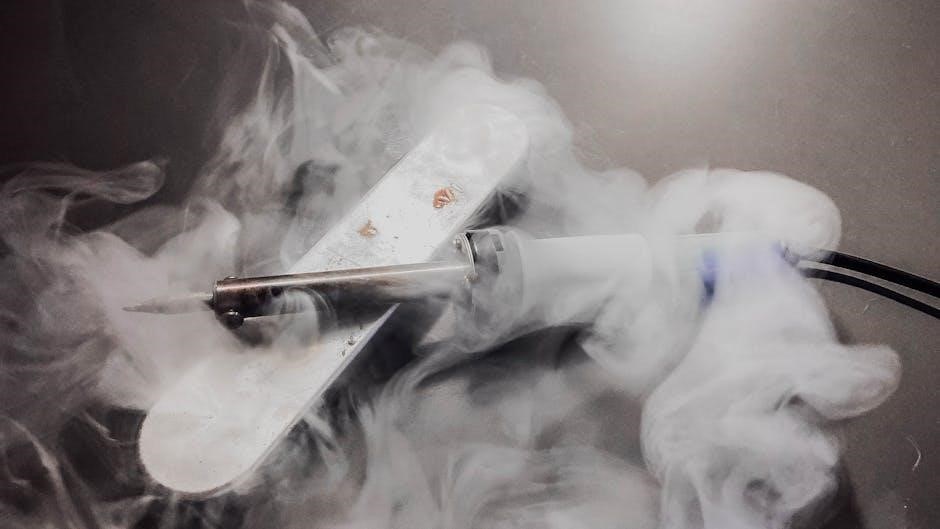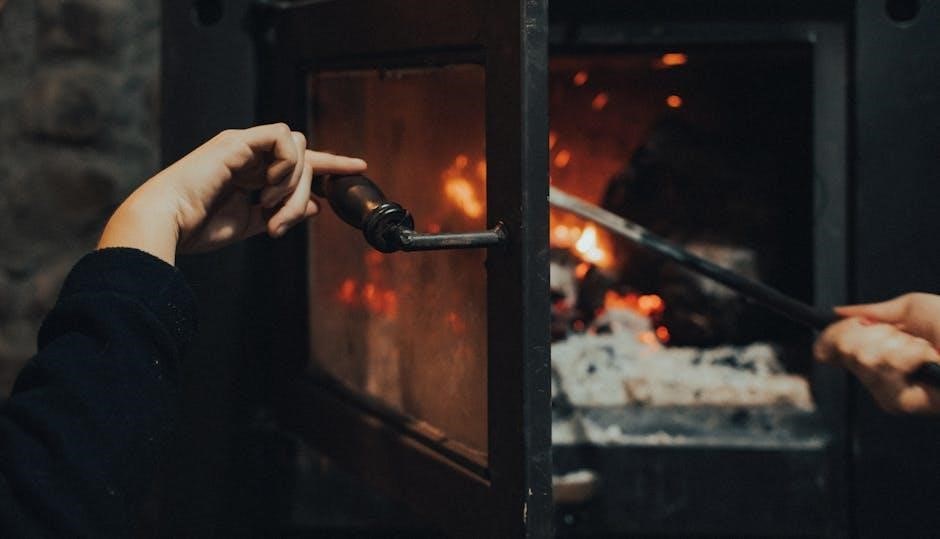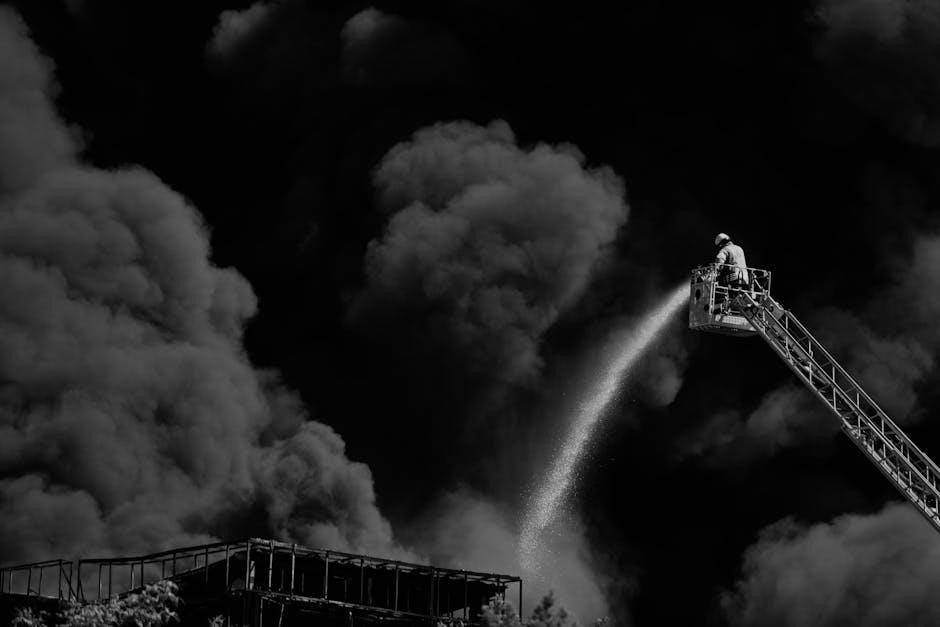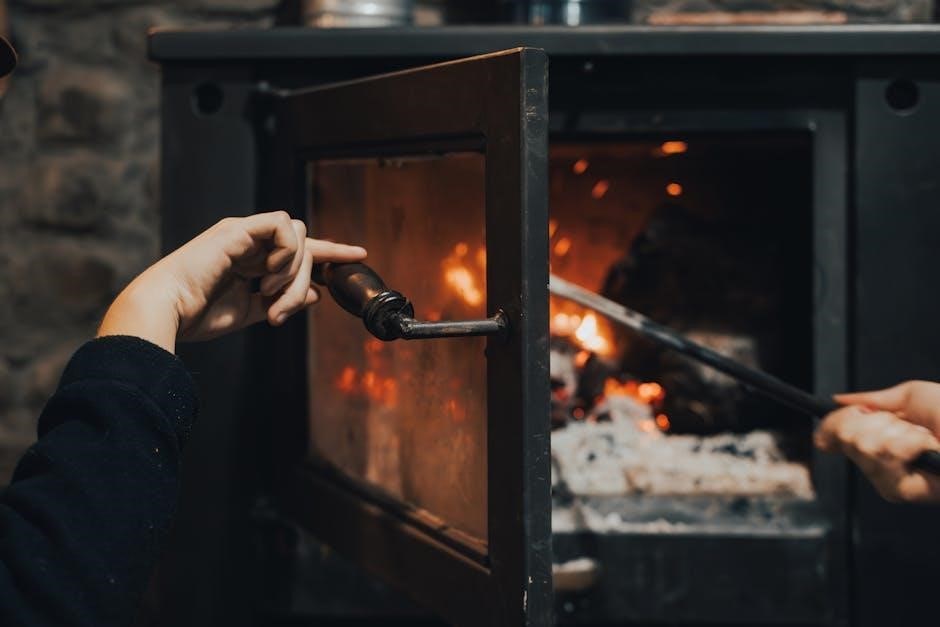first alert smoke co detector manual
First Alert Smoke & CO Detectors provide essential safety by detecting smoke and carbon monoxide, offering early warnings to protect your home and family. This manual guides proper installation, maintenance, and operation to ensure reliability and compliance with safety standards.
Overview of First Alert Smoke & CO Detectors
First Alert Smoke & CO Detectors are state-of-the-art devices designed to provide early warnings for smoke and carbon monoxide threats. These detectors are engineered to meet strict safety standards, including UL 217 and UL 2034, ensuring reliable performance. Available in various models, they offer features like voice alerts, smart home integration, and combination units that detect both smoke and CO. User manuals and guides are readily available, providing detailed instructions for installation, maintenance, and troubleshooting. These detectors are a crucial part of any home safety plan, offering peace of mind with advanced detection capabilities.
Importance of Proper Installation and Maintenance
Proper installation and maintenance of First Alert Smoke & CO Detectors are critical for ensuring reliable performance and protecting your home and family. Incorrect placement or failure to maintain the device can lead to false alarms or reduced detection accuracy. Regular tasks, such as testing the alarm monthly, cleaning dust from sensors, and replacing batteries, are essential for optimal functionality. Adhering to the manufacturer’s guidelines ensures compliance with safety standards like UL 217 and UL 2034, maximizing protection and minimizing risks associated with smoke and carbon monoxide threats.

Key Features of First Alert Smoke & CO Detectors
First Alert Smoke & CO Detectors offer dual sensing, voice location alerts, smart app integration, and compliance with UL 217 and UL 2034 standards for enhanced safety.
Smoke Detection Capabilities
First Alert Smoke Detectors are designed to detect smoke particles generated by combustion, providing early warning for fires. They utilize advanced photoelectric or ionization sensors to identify smoke quickly. These detectors meet UL 217 standards, ensuring reliable performance. Some models feature voice alerts, pinpointing the location of the smoke. Others include smart features like app notifications. The alarms produce loud, piercing sounds to alert occupants. LED indicators flash during smoke detection, ensuring visibility. Regular testing and maintenance, as outlined in the manual, are crucial for optimal functionality. Proper installation near sleeping areas and kitchens is recommended for comprehensive protection.
Carbon Monoxide Detection Features
First Alert Smoke & CO Detectors include advanced carbon monoxide sensing technology to monitor CO levels in your home. These detectors use electrochemical sensors to detect CO concentrations, alerting you with a loud horn and LED indicators when dangerous levels are present. Designed to meet UL 2034 standards, they provide reliable detection of this odorless and invisible gas. The alarms differentiate between smoke and CO threats with unique horn patterns. Some models offer voice alerts, identifying the hazard and its location. Proper placement in living areas ensures early detection, protecting against CO poisoning risks. Regular testing, as per the manual, ensures optimal performance and safety.
Combination Smoke & CO Detector Benefits
First Alert’s combination smoke and carbon monoxide detectors provide dual protection in a single unit, reducing installation and maintenance efforts. These alarms detect both smoke particles and CO levels, ensuring comprehensive safety. They minimize false alarms and offer clear alerts for different hazards. With features like voice notifications and LED indicators, they enhance emergency responses. Interconnectivity options allow all units to sound simultaneously, ensuring full home coverage. Energy-efficient designs with battery backup ensure continuous monitoring during power outages, providing peace of mind and compliance with safety standards.

Installation Guidelines
Install smoke & CO detectors on ceilings or walls, ensuring they are at least 4 inches from corners. Adhere to local codes and manufacturer guidelines for safe and effective installation to ensure optimal protection.
Choosing the Right Location for Smoke & CO Detectors
Proper placement of smoke and CO detectors is crucial for optimal protection. Install detectors on every level of your home, inside or outside sleeping areas, and near fuel-burning appliances. For smoke detectors, place them on ceilings or walls, at least 4 inches away from corners and 12 inches from cooking appliances to minimize false alarms. Avoid areas near windows, doors, or ducts. For CO detectors, install them at knee height or on ceilings, as CO spreads evenly. Ensure detectors are interconnected for whole-home coverage and follow NFPA 72 and 720 guidelines for placement accuracy.
Step-by-Step Installation Process
Begin by reading the manual thoroughly. Choose the correct location for your detector, ensuring compliance with local codes. Open the packaging and assemble the mounting bracket using the provided hardware. Attach the bracket to the wall or ceiling, following the manufacturer’s guidelines. Insert the battery or connect the wiring, depending on your detector type. Mount the detector onto the bracket and test it using the test/silence button. Ensure the alarm sounds and the LED light activates. Perform a final inspection to confirm proper installation and functionality. Refer to the manual for specific model instructions.
Mounting Types: Ceiling vs. Wall Installation
First Alert Smoke & CO Detectors can be installed on either the ceiling or wall, depending on your preference and local building codes. Ceiling-mounted detectors are generally more effective, as smoke rises, and should be placed near the center of the ceiling; For wall installation, detectors should be mounted between 4 and 12 inches from the ceiling. Ensure the detector is at least 4 inches away from any wall or corner for optimal performance. Always follow the manufacturer’s guidelines and local regulations for proper placement and installation.

Maintenance and Troubleshooting
Regular maintenance ensures your First Alert Smoke & CO Detector functions properly. Clean the sensor, test monthly, and replace batteries annually. Address chirping or false alarms promptly for reliable protection.
Monthly Maintenance Checklist
Perform monthly checks to ensure your First Alert Smoke & CO Detector operates effectively. Test the alarm by pressing the test/silence button to verify it sounds. Clean the sensor with a vacuum cleaner to remove dust. Check battery levels and replace them if necessary. Ensure the detector is securely mounted and properly installed. Review emergency escape plans with household members. Inspect for any damage or wear. Address any issues promptly to maintain reliable protection against smoke and carbon monoxide threats.
Handling False Alarms and Chirping Sounds
False alarms and chirping sounds can occur due to dust, steam, or low batteries. To address this, press the test/silence button to mute the alarm temporarily. Clean the detector with a vacuum to remove debris. Ensure proper installation away from kitchens and bathrooms to reduce false triggers. Replace batteries annually or as indicated by the manufacturer. If issues persist, check for system interconnectivity problems or sensor malfunctions; Regular maintenance helps minimize false alarms, ensuring reliable detection of actual threats while maintaining peace of mind for your household.
Battery Replacement and Care
Replace batteries in your First Alert Smoke & CO Detector annually or when the low-battery chirp sounds. Use the recommended 9V battery for optimal performance. Turn off the power or remove the old battery before replacing it. Ensure the new battery is securely installed to avoid false alarms. For hardwired models, replace backup batteries during routine maintenance. Proper battery care ensures continuous protection, while neglecting it may cause system failures, leaving your home vulnerable to undetected threats.
Troubleshooting Common Issues
Identify common issues with your First Alert Smoke & CO Detector by checking for error codes or LED patterns. A flashing red light may indicate a problem, while a chirping sound signals low battery or sensor issues. Ensure the detector is clean and free from dust, which can cause false alarms. Reset the device by disconnecting power or removing the battery for 30 seconds. For persistent issues, refer to the user manual or contact First Alert support for assistance. Regular troubleshooting ensures your detector operates effectively and provides reliable protection.

Understanding Detector Alerts
First Alert Smoke & CO Detectors use unique horn patterns, LED indicators, and beep sequences to signal smoke, CO, or system issues, ensuring clear communication of potential threats.
Different Horn and Beep Patterns
First Alert Smoke & CO Detectors use distinct horn and beep patterns to indicate different alerts. For smoke detection, a loud, continuous tone signals a potential fire. Carbon monoxide alerts emit a repeating pattern of four short beeps, followed by a five-second pause. A single chirp every 30 seconds indicates a low battery, while three chirps signal a system malfunction. Understanding these patterns helps users respond appropriately to emergencies, ensuring safety and timely action. These audible signals are designed to be clear and recognizable, even in stressful situations.
LED Light Indicators and Their Meanings
First Alert Smoke & CO Detectors feature LED lights that provide visual feedback. A steady green light indicates normal operation and a functioning detector. During a smoke or CO alarm, the red light flashes rapidly, signaling an emergency. If the detector is in silence mode, the red light flashes once every 10 seconds. Additionally, a yellow light may indicate a low battery or system malfunction. These LED indicators help users quickly assess the detector’s status, ensuring proper function and timely response to potential threats.
How to Silence the Alarm
To silence a First Alert Smoke & CO Detector during a false alarm, press and hold the test/silence button until the alarm stops. This feature temporarily mutes the detector, allowing you to investigate the cause. For smoke alarms, opening windows or using a fan to clear the area may help. If the alarm is due to a CO detection, ensure all occupants exit the premises immediately. After silencing, check for potential sources of the alert and verify the environment is safe. If the issue persists, consider replacing the detector or consulting the user manual for further guidance.

Frequently Asked Questions
Common questions include how to silence alarms, replace batteries, and troubleshoot issues. Users often inquire about product registration and finding replacement models. Visit the FAQ section for detailed answers.
What is the Difference Between Smoke and CO Alarms?
Smoke alarms detect particles from combustion, triggering alerts during fires. CO alarms sense carbon monoxide levels, alerting to toxic gas leaks. Each serves a unique purpose, but combination units offer dual protection. Smoke alarms meet UL 217 standards, while CO alarms comply with UL 2034. First Alert models often combine both for comprehensive safety. Understanding their differences ensures proper installation and maintenance for optimal home protection. Always refer to manuals for specific features and compliance with local codes. Both are crucial for a complete safety system, addressing distinct hazards in the home environment.
Can Smoke & CO Detectors be Interconnected?
Yes, First Alert Smoke & CO Detectors can be interconnected, enhancing home safety by ensuring all alarms sound when one detects smoke or CO. This feature provides early warning throughout the house, improving evacuation time. Interconnected systems require compatible models and proper wiring or wireless connectivity. Refer to the manual for specific interconnection instructions and compatibility details. Always follow local building codes and manufacturer guidelines for installation. Interconnecting detectors creates a unified safety network, maximizing protection against fire and carbon monoxide threats in every room of your home.
How Often Should Detectors be Replaced?
First Alert Smoke & CO Detectors should be replaced every 10 years from the date of manufacture, as specified in the manual. The sensors degrade over time, reducing reliability. Check the expiration date on the back of the detector or in the user manual. Replace the unit immediately if it exceeds its lifespan or shows signs of wear. Do not use detectors beyond their recommended lifespan, as this compromises safety. Always follow the manufacturer’s guidelines for replacement to ensure continuous protection against smoke and carbon monoxide threats in your home.

Interconnecting Smoke & CO Alarms
Interconnecting smoke and CO alarms ensures all units sound an alert when one detects smoke or carbon monoxide, enhancing whole-house safety and providing timely evacuation notices.
Benefits of an Interconnected System
An interconnected system ensures all smoke and CO alarms in your home sound simultaneously when one detects a threat, providing consistent alerts throughout the house. This uniform notification helps occupants quickly identify potential dangers, regardless of where they are. The system also allows for centralized monitoring, ensuring no threat goes unnoticed. Additionally, interconnected alarms can pinpoint the location of the hazard, aiding in faster evacuation. This setup is particularly beneficial in larger homes, ensuring comprehensive safety coverage and compliance with modern safety standards for optimal protection.
How to Interconnect Multiple Detectors
To interconnect First Alert smoke and CO detectors, start by ensuring all units are compatible and wired with an interconnect cable. Connect the wires between devices, following the manufacturer’s wiring diagram. Securely mount each detector in strategic locations, such as bedrooms and hallways. Test the interconnect feature by triggering one alarm to confirm all devices activate. Regularly inspect connections and test the system to maintain reliability. Always refer to the user manual for specific instructions tailored to your model, ensuring a seamless and safe installation process for your home’s protection.
Troubleshooting Interconnected Systems
If your interconnected smoke and CO detectors malfunction, check wiring connections for damage or looseness. Ensure all units are powered and backups like batteries are functional. If alarms trigger without cause, reset the system by silencing and testing again. Verify that all devices are compatible and properly synced. Consult the user manual for specific error codes or LED patterns, which can indicate issues like faulty sensors or wiring problems. Regular testing and maintenance help prevent false alarms and ensure reliable protection for your home and family.

Smart Home Integration
First Alert Smoke & CO Detectors integrate seamlessly with smart home systems, enabling remote monitoring and alerts through the First Alert mobile app for enhanced home safety and convenience.
Compatibility with Smart Home Systems
First Alert Smoke & CO Detectors are compatible with popular smart home systems like Amazon Alexa and Google Home, enabling voice control and seamless integration. The detectors can connect to the First Alert mobile app, allowing users to receive real-time notifications and monitor their home’s safety remotely. This integration ensures that you stay informed about potential threats, even when you’re not at home. The app also provides features like custom notifications and voice alerts, enhancing your ability to respond quickly to emergencies. This smart connectivity makes it easier to maintain a safe and secure living environment.
Using the First Alert Mobile App
The First Alert Mobile App allows users to monitor their Smoke & CO Detectors remotely, receiving real-time notifications for alerts, low battery warnings, and system status updates. The app provides customizable settings, enabling users to tailor notifications to their preferences. It also offers voice notifications, alerting you to the specific location of the threat in your home. Additionally, the app guides troubleshooting and maintenance, ensuring your detectors remain functional. This convenient tool enhances home safety by keeping you informed and in control, no matter where you are.
Remote Monitoring and Alerts
First Alert’s remote monitoring feature allows you to stay informed about your home’s safety from anywhere. Through the mobile app, receive instant alerts for smoke, CO detection, or low battery levels. The system sends notifications directly to your smartphone, ensuring you’re always aware of potential threats. Voice alerts provide specific details, such as the location of the issue, helping you respond quickly. This feature enhances peace of mind, especially when you’re away from home, by keeping you connected to your safety system at all times.

Fire Safety Tips
Ensure smoke and CO detectors are installed on every level of your home. Test detectors monthly and create an escape plan. Prevent CO leaks by maintaining heating systems and never using generators indoors.
General Fire Prevention Measures
Preventing fires and carbon monoxide leaks is crucial for home safety. Ensure proper installation and maintenance of smoke and CO detectors. Keep flammable materials away from heat sources and never leave cooking unattended. Store chemicals and fuels in well-ventilated areas. Avoid overloading electrical outlets and ensure appliances are in good condition. Regularly inspect heating systems and chimneys to prevent CO buildup. Develop a fire escape plan and practice it with your family. Stay informed about fire hazards and take proactive steps to minimize risks.
Creating an Emergency Escape Plan
Developing a clear escape plan is vital for home safety. Identify at least two escape routes from each room and designate a safe meeting spot outside the home. Ensure all family members understand the plan and practice it regularly. Assign a responsible person to assist young children or individuals with special needs. Stay low while escaping to avoid smoke inhalation and never use elevators during a fire. Familiarize yourself with emergency Exit signs and keep emergency numbers handy. Smoke and CO detectors can provide early warnings, allowing time to execute the plan effectively.
Preventing Carbon Monoxide Leaks
Preventing carbon monoxide leaks is crucial for home safety. Ensure proper ventilation for fuel-burning appliances like furnaces, water heaters, and generators. Regularly inspect these devices and chimneys for blockages or damage. Never use generators or grills indoors, as they emit CO. Keep gas appliances well-maintained and avoid running cars in garages. Install CO detectors near sleeping areas for early alerts. Schedule annual professional inspections of heating systems to prevent leaks. Addressing these steps reduces CO risks, ensuring a safer living environment for your family.
Regulatory Compliance
First Alert Smoke & CO Detectors meet UL 217 and UL 2034 standards, ensuring compliance with national and local building codes for safety and reliability.
UL 217 and UL 2034 Standards
First Alert Smoke & CO Detectors comply with UL 217 and UL 2034 standards, ensuring reliable performance in smoke and carbon monoxide detection. UL 217 focuses on smoke alarm sensitivity and response time, while UL 2034 verifies carbon monoxide detector accuracy. These certifications guarantee the devices meet rigorous safety and operational benchmarks, providing consistent protection. Compliance with these standards ensures the detectors function effectively, offering peace of mind and adherence to local regulations.
National and Local Building Codes
First Alert Smoke & CO Detectors are designed to meet or exceed national and local building codes, ensuring compliance with safety regulations. These codes often require specific installation locations, such as outside sleeping areas and on every level of the home. Detectors must also meet standards like NFPA 72 for smoke alarms and NFPA 720 for carbon monoxide alarms. Always verify local requirements before installation, as some jurisdictions may have additional specifications. Compliance ensures optimal protection and adherence to legal standards for home safety; Proper installation is critical for reliable performance and code satisfaction.
Certifications and Approvals
First Alert Smoke & CO Detectors are certified to meet rigorous safety standards, including UL 217 for smoke alarms and UL 2034 for carbon monoxide detectors. These certifications ensure the devices accurately detect threats and function reliably. Additionally, they comply with national standards and local regulations, providing assurance of their effectiveness. The certifications also cover aspects like sensor accuracy, alarm loudness, and durability. By adhering to these standards, First Alert detectors offer enhanced safety and peace of mind for homeowners. Always look for these certifications when selecting a smoke or CO detector for your home.

Customer Support and Resources
First Alert provides dedicated customer support, including product registration, user manuals, and troubleshooting guides. Contact their support team via phone or email for assistance with smoke and CO detectors.
Product Registration Process
First Alert’s product registration ensures your smoke and CO detector is covered under warranty and provides access to exclusive support. Visit their official website to register your device by entering the model number and purchase details. This process helps track your product and offers personalized assistance. Registration also enables notifications for software updates and recalls, ensuring optimal performance and safety. For assistance, contact First Alert’s consumer support team via phone or email. Proper registration is crucial for maintaining your detector’s reliability and extending its warranty period effectively.
Contacting First Alert Consumer Support
First Alert’s consumer support team is available to assist with questions or concerns regarding your smoke and CO detector. You can reach them by calling their toll-free number, 1-800-323-9005, during business hours. Additionally, visit their official website for online support options, including live chat and email forms. The support page also offers a comprehensive FAQ section and downloadable resources, such as user manuals and troubleshooting guides. For quicker service, have your product’s model number ready when contacting support to ensure a prompt and effective resolution to your inquiries.
Accessing User Manuals and Guides
First Alert provides easy access to user manuals and guides for their smoke and CO detectors. Visit their official website at www.firstalert.com and navigate to the support section. From there, you can search for your specific model using the product name or model number. Manuals are available in PDF format for free download, ensuring you can access essential installation, maintenance, and troubleshooting information. Additionally, the website offers troubleshooting guides and FAQs to address common concerns, helping you maximize the performance and safety of your detector.
Leave a Reply